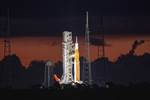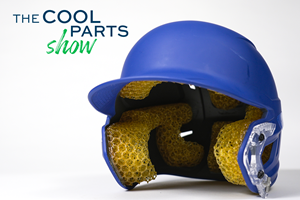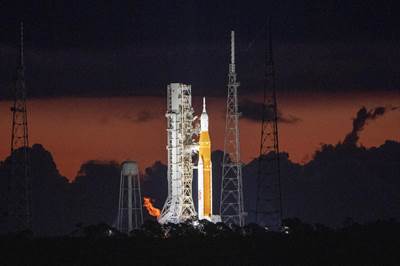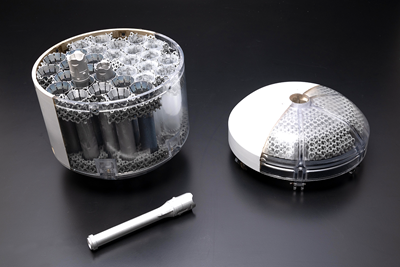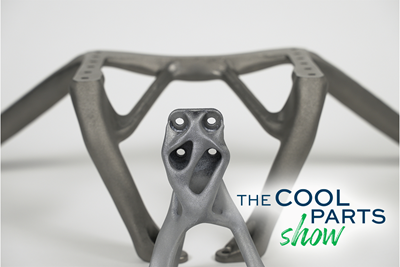Share
Read Next
Scroll to unlock this premium content if video does not play.
When we talk about spacecraft, we are largely talking about propulsion.
About 70% of the cost of a spacecraft, along with considerable manufacturing lead time, is attributable to the propulsion system alone. That means the chance to streamline the design and production of this system offers the chance to deliver dramatic time and cost savings in spacecraft manufacturing. NASA’s Rapid Analysis and Manufacturing Propulsion Technology (RAMPT) program aims to apply additive manufacturing to this challenge, transforming what has historically been an elaborate assembly (in part because of the complexity of the cooling network) into a unified 3D printed structure. Accomplishing this is such a big job, it takes two additive processes. The Cool Parts Show visited NASA’s Marshall Space Flight Center in Huntsville, Alabama, to learn about a single-piece, multi-metal thrust chamber assembly made through laser powder bed fusion of copper alloy joined to nickel superalloy via directed energy deposition. Propulsion systems made this way could be produced in days instead of months, with significantly less effort and material waste. | This episode of The Cool Parts Show is sponsored by Carpenter Additive
The Cool Parts Show is a video series from Additive Manufacturing Media that explores the what, how and why of unusual 3D printed parts. Watch more here.
Have a cool part to share? Email us.
Related Resources
- NASA’s Marshall Space Flight Center
- For other NASA cool parts, see our episodes about “evolved” brackets developed at Goddard Space Flight Center, collapsible lattices designed at Jet Propulsion Laboratory, and parts for the Perseverance Mars Rover.
Transcript
Stephanie Hendrixson
We're coming to you today from the NASA Marshall Space Flight Center in Huntsville, Alabama.
Peter Zelinski
This thrust chamber assembly is made from laser powder fusion down here, directed energy deposition up here.
Stephanie Hendrixson
Two metal 3D printing processes in one spacecraft part. On this episode of The Cool Parts Show.
Peter Zelinski
The thrust chamber assembly: Except in this form, it is much, much less of an assembly. Thanks to additive manufacturing, this structure was produced almost entirely in one single solid, fused together, intricate metal piece. Multiple metals, actually. We'll get to that. Here's the combustion chamber. Here is the nozzle. When we talk about spacecraft, we are largely talking about systems like this because the propulsion systems make up something like 70% of the cost of a spacecraft. And conventionally this is an assembly. There are many, many intricate components joined together in sophisticated processes. This is difficult to manufacture.
Stephanie Hendrixson
That's right. And so NASA has now developed this methodology where they're now doing 3D printing in succession using two different processes on two different printers, at least three materials involved here and we're going to talk about all of that.
Peter Zelinski
So multiple materials, multiple metals are part of this. Multiple research teams involved in this work as well. So we are at NASA's Marshall Space Flight Center in Alabama. Other partner organizations in this work have included, for example, the Glenn Research Center, Ames Research Center, Langley Research Center. The acronym covering all of this work is RAMPT, Rapid Analysis for Manufacturing Propulsion Technology. NASA is very interested in bringing down the cost and bringing down the time to manufacture propulsion systems like this. Additive manufacturing figures into that significantly, and this successful 3D printing build illustrates the beginnings of what's going to be possible.
Stephanie Hendrixson
That's right. The thrust chamber assembly that NASA ultimately wants to build this way is going to be ten feet tall, eight feet in diameter, rated for 500,000 pounds of thrust. The one that we have here with us today is for 40,000 pounds of thrust. But even getting to this size component, it's involved a lot of development, a lot of work, and we want to introduce somebody who knows a lot about that. This is Paul Gradl, principal engineer here at NASA.
Paul Gradl, NASA
At the heart of RAMPT, we're looking at the thrust chamber assembly or the TCA. And from the outside, these may look very simple. An hourglass shape on these, but they're very complex. They have a series of cooling channels within the walls. And on one side, within the combustion chamber, you have the combustion process upwards of 6000 degrees Fahrenheit or over 3000 degrees Celsius gases, hot gases that you're combusting. And the combustion chamber is going to expand those gases through the nozzle, creating thrust for the engine. In order to maintain wall temperatures so the material doesn't melt, we have to include the series of these integral channels and we run the propellants through these channels. And sometimes these wall thicknesses can be just a few sheets of paper thick.
Peter Zelinski
Integral channels. So we can see where this is going. So a structure like this that has to operate at high temperature, the way that's achieved is with a sophisticated array of channels running through this solid form to carry cooling fluid through this structure. And the conventional way to manufacture that system is to build the inside first, build that array of channels, and then build the outer structure around it. A lot of assembly, a lot of components coming together, a lot of different stations where assembly work is done, many different operations, many different companies involved. So what all of that means is a lot of complexity to production, resulting in manufacturing being, difficult and expensive and time consuming.
Paul Gradl, NASA
When you’re looking at how thrust chambers are manufactured conventionally, we would use brazing and plating operations. There's a lot of specialty skills in some of these operations. You can have long lead times for forging and castings. There's a lot of machining operations. So typically we'd start out with maybe a 500 or 1,000 pound forging that would machine 90% of the copper material away. And then you have to slot all these channels in there, and then we use the brazing and plating to close out these channels. You can find high scrap rates with some of these assembly operations. And again, there's only a handful of expertise companies that can take on some of these unique brazing and plating operations.
Peter Zelinski
So what is striking to me about that is the thousand pound forging. Right? This thousand pound forging made of this special NASA engineered copper alloy. So you have that made and you have that shipped, and you pay for all of that, and then you machine 90% of it away to get the form that you really want. And we know that's how it's done. That's how aircraft parts are made. That's how spacecraft parts are made. But still, it's crazy that that is necessary.
Stephanie Hendrixson
And so now by using additive manufacturing, NASA is able to manufacture net shape or near net shape components, which really dramatically reduces the amount of machining that you have to do, the amount of scrap that comes out of this process. And then they're also getting all kinds of benefits from assembly consolidation too.
Peter Zelinski
Right? Right. Because you machine away 90% of the mass. And that's not even the challenging part. The challenging part is making all of these precise closures and connections through sophisticated brazing processes done by skilled technicians, all to build this very accurate assembled structure.
Stephanie Hendrixson
And all of these things that we're talking about, all of these factors add up to make producing a part like this, much easier, faster, less expensive, and less prone to failure.
Paul Gradl, NASA
Additive manufacturing has a lot of advantages in this. We can print these as a single piece or a few pieces or consolidating the parts. I don't have the long lead time with the forging the castings. I've minimized all the machining operations on these. And of course, since with additive we can create complex features, we can build all of these coolant channels directly in there for the propellants to flow through. So the complexity of additive we find advantages there, the ability to make unique materials such as the GRCop-42 material and some of the other copper alloys, and of course huge reduction in the cost and the schedule associated with thrust chamber manufacturing.
Stephanie Hendrixson
So NASA is realizing all kinds of benefits from assembly consolidation through additive manufacturing. And we've seen that in other parts on the show. But typically when we talk about assembly consolidation, we're talking about just one printer, probably just one material, and that's not the case here. So let's talk about all the different sections of this part and how they are made.
Peter Zelinski
Conventional manufacturing has limitations, NASA's getting beyond that. Additive manufacturing has limitations, and NASA has to get beyond that too. And the way they've done that with this part is by employing multiple different approaches to metal 3D printing for different sections of this structure. So let's talk about workflow. So the first part of the structure produced is the combustion chamber. It's made out of that NASA copper alloy GRCop-42. It is made through laser powder bed fusion on a machine from EOS.
Paul Gradl, NASA
We find that we need to use different additive manufacturing processes for different components. Of course, laser powder bed fusion is great for fine features and some of the unique alloys that we're trying to build for thrust chambers, but we're limited in the overall volume that we can build. For a thrust chamber assembly, the core part of this is your combustion chamber, where your combustion process is taking place. You know, very hot gases in there. So again, we have to use GRCop-42, which is a copper chrome niobium material, copper based, as the liner in here. So we print this with all of the channels, integral channels in there and we're limited in the overall build volume of this. Powder bed fusion, we're typically in that 250 millimeter diameter with most of the platforms. Several platforms are moving up to 600 millimeter, and 800 millimeter diameter. Which again allows us a lot of advantages to make these large combustion chambers with the fine features.
Peter Zelinski
After laser powder bed fusion there's some post-processing, hot isostatic pressing, some machining, then it's ready for the next step.
Stephanie Hendrixson
So laser powder bed fusion is great for the fine features in that combustion chamber. But to build this larger structure, NASA then switches over to a different process, directed energy deposition or DED. So that allows for the larger part of the nozzle to be built, and also for transitioning the material away from GRCop-42 to something else.
Paul Gradl, NASA
The next step in the process for RAMPT is after we have our combustion chamber completed and all the post-processing is we will clad on what we called manifold preparations is we use the laser powder direct energy deposition process to clad on either an Inconel 625 or the NASA HR-1 material and some of these materials such as the NASA-HR-1 not being compatible completely with the GRCOP-42 material. We have to use an interface material such as a copper nickel on this. We want to avoid any deleterious phases in the material and thus this interface material.
Peter Zelinski
DED, directed energy deposition. So now metal 3D printing not with a bed of powder, but with powder flowing through a nozzle and deposited that way. And one of the possibilities that this brings is altering the mixture of that metal as you go. Introducing a transition from one material to another through a gradual gradient to allow for the most integration and interlocking of those two materials. And that's particularly important first, for joining manifolds to the combustion chamber manifolds also made through laser powder bed fusion, but made through a different material, Inconel 625. DED is used for the transition between those two elements, but then it is done on a very large travel DED machine from RPM Innovations, and the large travel becomes important because the same process, the same machine is also used to 3D print this large feature.
Paul Gradl, NASA
So we partnered with RPM Innovations as part of our development under the RAMPT project to do the development, working with a lot of their different machines and processes. And part of this is we're able to go very large scale in the machines and get the features that we were looking for. We were trying to obtain about a one millimeter or a 40 thousandths wall thickness with a lot of these, and we did a lot of early development on that and we're able to really control the channel sizes and the wall thicknesses required for the thrust chamber design using that process. So we're using the same machine for both the bi-metallic cladding for the manifold preparations and some limited areas of the jacket on the combustion chamber. But we're also using the laser powder DED process for forming the nozzle. There's a lot of development in characterizing both the material, the geometry that we're getting out of the material from the DED process, mechanical properties of the material and eventually we’re able to move on to develop and deposit the nozzle directly onto the combustion chamber.
Stephanie Hendrixson
And so if we think back to the conventional way that one of these thrust chamber assemblies would be put together, this is really exciting. Now, instead of having all of those different little pieces, all of those tubes that need to be brazed together, things that need to be bonded and lined up just right, now NASA is able to begin to build some of these features, like those integrated channels, with laser powder bed fusion, and then continue them on through the rest of the part with DED. So there's a lot less assembly that's happening. There's fewer moving pieces, there's less that can go wrong.
Paul Gradl, NASA
We tend to think of additive manufacturing and all the advantages that it provides for the parts that we're building. But I think one thing that's very unique about additive is we are able to advance other manufacturing technologies because of additive. So in this case of the RAMPT project, we saw an opportunity that instead of doing a fully cladded structural jacket, we could use a composite over wrap, which is about a 35 to 40% weight reduction over a metallic jacket. And additive manufacturing enabled this, the ability to build the combustion chamber and the nozzle as a single piece with all the channels integrated, we have a very fine closeout of those channels in the back side, and then we can use the composite over wrap filament winding to provide the structural jacket to react all the loads, the thrust loads, the pressure loads within the thrust chamber assembly. This eliminates distortions. So we typically see higher distortions on the order of 3 to 10% when we're cladding, which means that my combustion chamber is going to shrink both the radius and the overall length of that. And the composite overwrap eliminates distortions from the cladding in addition to providing a significant weight advantage for us.
Stephanie Hendrixson
So even though we're dealing with multiple types of 3D printers, multiple materials here, multiple processes, this is still a more efficient way to go about building a thrust chamber assembly than it would be done conventionally. So just fewer parts to deal with, fewer processes, fewer suppliers involved, and less manual labor overall.
Peter Zelinski
And all those benefits, as great as they are, they're not enough. Ultimately, this 3D printed thrust chamber assembly has to prove that it can perform as effectively, as reliably as the assembly that it replaces.
Paul Gradl, NASA
And with thrust chamber development, both the manufacturing development, material development, you're going to find a lot more going through the hot fire testing. We build parts, we test them, and if something is going to go wrong, it can go wrong in milliseconds. So we believe that it's very important to design, develop, manufacture these parts, but put them through the paces of hot fire testing. Prior to hot fire testing, we do proof testing and we validate all the material properties. We do inspections on these, but hot fire testing is going to combine all of the loads. We're going from cryogenic temperatures all the way up to elevated temperatures in a matter of a few seconds. So you're seeing these extreme thermal gradients that materials are incredibly challenged by. You see very high strains during those testing. Of course, the hot gases in there, the high pressures, and we can't simulate that with individual tests. We have to have that combined loading. So being able to take the RAMPT technology and these thrust chambers through that full, what we call design-fail-fix cycle and iterate on it is incredibly important. So we're not just building shapes anymore. We're building parts with pedigree.
Stephanie Hendrixson
So as we've said, this is a smaller version of the thrust chamber assembly that NASA ultimately wants to build. But this design has been successfully hot fire tested, and now NASA is using the lessons learned to scale up.
Paul Gradl, NASA
Developing a full scale thrust chamber using the RAMPT technology first time through took us years because we had to develop all of the materials, we had to develop the processes, we had to characterize the processes, the microstructure and the mechanical properties. But now that we've learned all those lessons and we understand each of the steps involved, we can develop a full scale thrust chamber in months. It's not years like it would be traditionally. The chamber itself, the powder bed fusion process, we can build these in a matter of days or weeks. We're in process of building a full scale RS 25 demonstrator nozzle for our space launch system that is eight feet in diameter and ten feet tall. So all of the RAMPT hardware and the thrust chambers have either been sized to address industry interest on this and industry alignment, or we're building parts from the RAMPT technology that have been scaled up to the needs of industry.
Related Content
8 Cool Parts From Formnext 2024: The Cool Parts Show #78
End-use parts found at Formnext this year address various aspects of additive's advance, notably AM winning on cost against established processes.
Read More3D Printed Spacer Grids for Nuclear Power: The Cool Parts Show #79
Westinghouse Electric Company is exploring laser powder bed fusion as a means of manufacturing spacer grids, critical parts of the fuel rod assemblies used in pressurized water reactors.
Read MoreHow 3D Printing Aids Sustainability for Semiconductor Equipment: The Cool Parts Show Bonus
Hittech worked with its customer to replace fully machined semiconductor trays with trays made via DED by Norsk Titanium. The result is dramatic savings in tool consumption and material waste.
Read More3D Printed Lattices Replace Foam for Customized Helmet Padding: The Cool Parts Show #62
“Digital materials” resulting from engineered flexible polymer structures made through additive manufacturing are tunable to the application and can be tailored to the head of the wearer.
Read MoreRead Next
Artemis I Has Launched: 3D Printing Applications for This Space Mission and Beyond: AM Radio #25B
On this episode of AM Radio, we discuss how additive manufacturing is enabling a new era of space exploration.
Read More3D Printed Lattice for Mars Sample Return Crash Landing: The Cool Parts Show Bonus
NASA Jet Propulsion Laboratory employs laser powder bed fusion additive manufacturing plus chemical etching to create strong, lightweight lattice structures optimized to protect rock samples from Mars during their violent arrival on earth.
Read More3D Printed "Evolved Structures" for NASA Exoplanet Balloon Mission: The Cool Parts Show #61
Generative design creates stiff, lightweight brackets for EXCITE mission monitoring planets orbiting other stars. The Cool Parts Show visits Goddard Space Flight Center.
Read More


